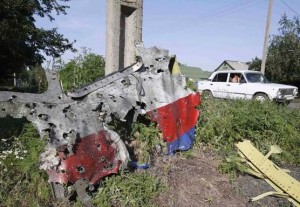The website, Vineyard Saker, has translated and published a 16-page study into the July 17, 2014 crash of Malaysian Airlines Flight 17 that was conducted by the Russian Union of Engineers. The Russian engineers conclude that the flight was brought down by a fighter aircraft operating in the vicinity of the passenger plane and that the only likely candidate for such an attack was an Su-25 or MiG-29 aircraft of the Ukraine armed forces.
The report noted pro-autonomy rebels in east Ukraine do not possess or operate a fighter aircraft. The doomed passenger flight had 298 people on board.
The engineers’ report said the commercial aircraft left Amsterdam for Kuala Lumpur and was flying 10,100 metres in Ukrainian airspace near Donetsk, likely on auto pilot, when it was attacked by a combat aircraft with 30 mm caliber cannon. The cockpit area of the Malaysia Airlines jet was struck, likely killing its crew and depressurizing the aircraft.
Since the plane was on auto pilot, it continued to fly but began to lose altitude. The attacking aircraft flew to the rear of MH17 and launched R-60 or R-73 missiles that caused loss of cabin pressure, destruction of the jet’s control system, failure of auto pilot and loss of ability to maintain its level flight path, leading to a tailspin.
The report said the jet broke up at a high altitude, resulting in the plane’s wreckage scattered over an area more than 15 square kilometres. It says no combat jet of the Armed Forces of the Russian Federation breached Ukrainian airspace. Ukraine and third party air surveillance reports confirm that.
According to an agreement signed on August 6 between Ukraine, The Netherlands, Belgium and Australia, all four parties must give their consent to the release of formal reports of the investigation of the crash. The Netherlands has been assigned the lead role in the international investigation… by the country where the plane came down, Ukraine, which happens to vigorously accuse Russia of the tragedy. Dutch authorities released a preliminary report on September 9 that answers few questions and dodges many.
Russian Defence Minister Sergie Shoigu has blamed Ukraine for the air tragedy, saying, “The catastrophe happened in the airspace belonging to Ukraine, which bears full responsibility for what happened.”
The UN Security Council held a special debate on the downing of MH 17 at Russia’s request on September 17. The debate featured U.S. representative Samantha Power repeating tired phrases that maybe pro-autonomy rebels in eastern Ukraine had some role in the downing of the flight.
The Russian engineers’ report is consistent with the visual images of the destroyed aircraft exterior panels that are visible on many website reports of the crash. It also fits the inadvertent statement of the spokesperson of the Organisation for Economic Security and Cooperation, the Canadian of Ukrainian origin Michael Bociurkiw.
Bociurkiw is an eyewitness to the aftermath of the MH17 crash and he told a CBC Television interviewer on July 29 that several sections of the fuselage were pockmarked with “what almost looks like machine gun fire. Very, very strong machine gun fire that has left these unique marks that we haven’t seen anywhere else [on the plane].”
Bociurkiw specifically refuted the missile theory: “We’ve also been asked, for example, ‘Have we seen any examples of a missile [strike]?’ Well, no we haven’t.”
See also: Families of German MH17 victims to sue Ukraine: lawyer, Reuters, September 21, 2014.



